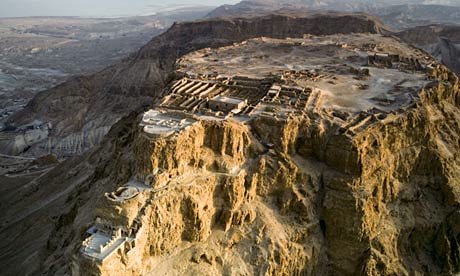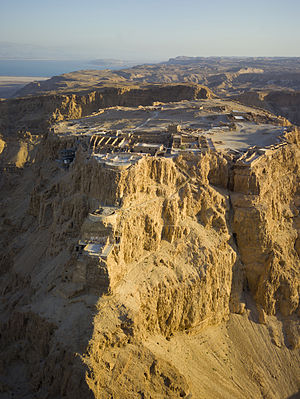
PHOTO: theguardian.com
The sun shivers through the arid air in the southern Jewish desert. The sky is blue as sapphires, the ground brown and red like brick. The Dead Sea sparkles a muddy turquoise, ringed by plains of white salt, and reigning over the landscape 450 meters high stands a circular, isolated rock plateau on the western end of the Judaean Desert. It’s name is Masada, and Masada saw the death of almost a thousand men, women, and children in the year AD 72.
The site was first identified in 1828 by Americans Edward Robinson and Eli Smith. In 1842, Samuel W. Wolcott and W. Tipping actually climbed the mountain to the top, and in 1959, the first probe excavation was conducted by Shmarya Guttman. The first extensive excavation of the site was conducted in 1963 and 1965 by Israeli archaeologist Yigael Yadin. The site had remained almost untouched by humans for almost two thousand years. A huge earthen ramp was still intact on the western side where the Romans had built it in order to climb up the mountain and lay siege to it by foot. They found remains of wall paintings, Roman-style bathhouses, one of the oldest synagogues in Israel, storehouses, and homes. All of these have been restored. Other important finds included fragments of two scrolls from Deuteronomy and Ezekiel, and many other fragments were found of both the Old Testament and of other sacred Jewish texts. But, there were other finds too, finds that lay in caves and beneath the arid soil of the mountain that hinted at Masada’s dark history: the scattered bones of young men, women, and children.
Let’s jump the story back a couple thousand years to what we know of Masada’s history as told by the famous Jewish historian: Josphus. According to him, the site was first built by the Hasmoneans, a ruling dynasty of Judea that predated the Herodian dynasty and traced itself all the way back to the Maccabees. Between 37 and 31 BC, Herod the Great fortified it as a refuge for himself in an event of a revolt, which ended up coming really in handy for the Jews later.
See, the Romans were ruling Judea (what’s now modern-day Israel) in the first century AD, and the Jews weren’t too happy about that. Around AD 60, several Jewish extremist groups began a revolt to try and push the Roman occupation out of Judea. Six years later, a Jewish extremist group called the Sicarii attacked the Roman garrison at Masada and hunkered themselves down there. By AD 70, more Sicarii poured into the fortress with their families after they’d been kicked out of Jerusalem for causing conflict. From then on, it was all downhill for the Jewish revolt.
Soon, the Romans had swept down from Rome to re-establish Roman power in the region. They completely destroyed Jerusalem, laid waste to the Jewish Temple, and carried off all of the sacred artifacts from the Temple as spoils of war. The Jews were subjugated, once again, to Roman rule. The last surviving rebels stayed holed up at the top of their mountain at Masada.
In AD 72, two years after the Jewish garrison had come to Masada, the Roman governor of Judea, Lucius Flavius Silva, decided to wipe out the Jewish revolt once and for all. He led an army 9,000 strong to the base of Masada, where almost one thousand Jewish Sicarii and their families lived. From the bottom of the desert floor, the mountain looked high, forbidding, and impregnable, but the Romans had an idea. They employed almost 6,000 men and women (many of whom were Jewish prisoners of war) to build an earthen ramp up the side of the mountain so they could lay siege to the fortress.
It was completed in the spring of the next year. A huge siege tower and giant battering ram were constructed and moved up the ramp while the Romans volleyed blazing torches against the walls of Masada. They breached the walls of the fortress on April 16, AD 73, but they didn’t get what they came for.
When the Romans finally broke down the walls after all that work, they found only a “Citadel of Death”. Every single person inside that fortress, down to the very last child, was found dead. They’d even set their own buildings ablaze. There was no one left to kill.
According to Josephus, since Judaism prohibits suicide, as the Romans lay siege to the walls of Masada, the Jewish defenders killed their wives and children first, and then cast lots to kill each other in turn. Only the very last man had to actually commit suicide. The Jewish commander told them to destroy everything but the food supply to make sure the Romans knew that they hadn’t just run out of supplies. They had chosen death over Roman enslavement.

PHOTO: UNESCO
The siege of Masada is often revered in modern Israel as a symbol of Jewish heroism. To Israel, Masada symbolizes the courage of their warriors and the mountain stands as a space of national heritage and a site of military ceremonies. It remains the site of one of the largest international archaeological expeditions ever launched, drawing almost 10,000 different people from over 28 different countries to help reveal the secrets and legacy the site held for Israel.
Though some modern Israelis are starting to become less comfortable with glorifying the mass suicide and identifying with religious fanatics, the site still remains an important historic piece in the puzzle of human history. It was there, two thousand years ago, that almost a thousand people took their stand against the crushing iron boot of one of the greatest empires the world has ever seen. They lost, yes, but their story deserves to be told nonetheless.
Masada has been made a UNESCO World Heritage Site, and is a popular destination for tourists and hikers, and still remains one of the most detailed archaeological sites in Israel. It stands today as a beautiful example of both Herodian architecture, Roman engineering, and Jewish culture and courage.


